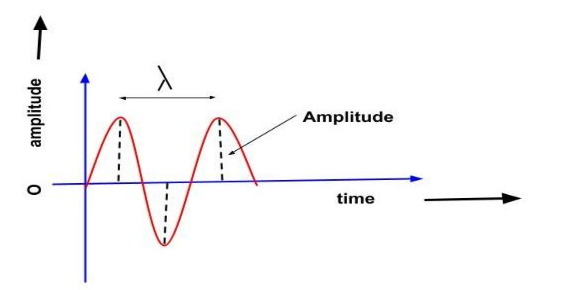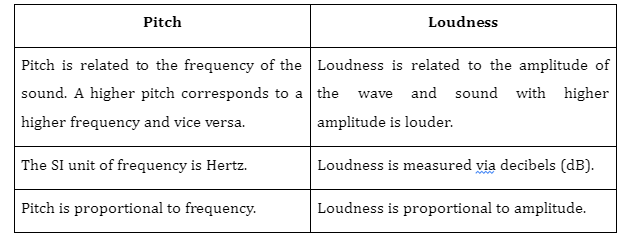Introduction
A wave is defined as the propagation of a continuous disturbance across two points. They can propagate with, or without a medium in between the given points and on this basis, they are broadly classified as follows:
- Mechanical waves: A wave that requires a medium to propagate. For sound waves cannot travel in vacuum.
- Electromagnetic waves: These waves need no medium to travel and thus, can travel in vacuum as well. Light is a common example of electromagnetic waves. They can also be defined as a pulse of energy that traverses through vacuum or a given medium.
Waves generally travel in the form of crests and troughs and are characterised by various factors like amplitude, velocity, frequency, etc. In simple terms, the amplitude is a measure of the energy they carry.
Define the Amplitude of a wave
The amplitude of a wave is a measure of the energy transferred by it and is defined as the distance from the axis to the bottom or top of a peak or valley of the wave. Generally, this value is expressed in metres (m), though other measurements exist as well. Amplitude determines how much the wave rises and falls and waves with higher amplitudes carry more energy than those with lower ones.
Mathematically, a sinusoidal wave can be represented by the following equation:


We can define amplitude in another way. It can be understood that the amount of displacement of a particle in the wave is an indication of the energy required to create its motion. This quantity of energy is expressed as the amplitude of the wave.
Sound
Sound is a form of energy that causes objects to vibrate. It can be transferred across two locations through a medium that may be solid, liquid, or gas. Sound waves are longitudinal in nature and thus, move in the form of compressions and rarefactions. When an object produces sound, its vibrations transfer energy to the molecules of the medium around it, which then propagate and reach our eardrums. Our ears convert these vibrations into signals that our brain can interpret as sound. The range of sound frequencies audible to humans is 20Hz to 20KHz, and frequencies above and below this range are known as ultrasound and infrasound, respectively.
Ultrasound waves
Ultrasonic waves mostly find use in the medical field in the diagnosis of various diseases. Processes like ultrasonography utilize ultrasounds.
Infrasonic waves
These are sound waves with frequencies below the 20 Hz mark, which are generally produced in natural phenomenon like volcanic eruptions, earthquakes, etc.
Define Amplitude in Physics?
In physics, amplitude refers to the maximum distance or displacement travelled by a vibrating body or wave from its resting point. All waves possess an amplitude and it is an important characteristic that defines waves.
Amplitude modulation is a technique used to modulate the amplitude of a given wave. Generally, a low amplitude wave is modulated using a carrier wave. This process allows us to transmit data across locations. Amplitude modulation has several applications such as signal transmission, radio broadcasting among others.
Characteristics of Sound
- Pitch: Pitch refers to the subjective sensation of the frequency of a sound wave. A high-frequency sound wave produces a high pitched sound, while a low-frequency sound wave produces a low pitched sound. Pitch or frequency is measured in Hertz (Hz).
- Loudness: The loudness of sound is determined by the amplitude or size of the sound wave. A larger size or amplitude corresponds to a louder sound. Loudness is measured in decibels (dB).
- Amplitude: Amplitude is the maximum displacement of the particles from their mean position as sound waves travel through the medium. It is expressed in metres.
- Wavelength: Sound is a longitudinal wave and it travels across two points via a medium in the form of compressions and rarefactions. It is characterised by a certain wavelength, which is defined as the distance between two consecutive compressions or rarefactions. Typically, these wavelengths lie between 1.7 cm to 17 metres.
Wavelength is connected to speed and frequency of sound via the following relation:
\[\lambda = \frac{v}{f}\]
- Frequency: The number of compressions or rarefactions that a sound wave produces in unit time is known as the frequency of the wave. It is expressed in Hertz (Hz), which is equal to one second inverse.
\[f = \frac{1}{T}\]
- Time period: The time taken for the particles of the medium to undergo a complete cycle from one compression to the next is known as the time period. Time period and frequency are inversely related. Its unit is second.
\[T = \frac{1}{f}\]
- Velocity: The velocity of the wave measures how fast the disturbance in the medium travels between two locations. It can vary depending on the medium in question and is expressed in (\(m{s^{ – 1}}\))
Velocity=Displacement/ time
Summary
Waves are a common phenomenon that we encounter in our day-to-day lives. For instaande , the light waves produced by the sun, the waves in the ocean, and the sound waves we hear. In terms of physics, waves are a way of transferring energy via a disturbance.
Sound waves are generated by a vibrating body that transfers energy to the molecules of the medium that surrounds it. This energy in the form of vibration then propagates through the medium. Sounds can take many forms, such as pleasant sounds, noise, music, etc. Understanding the characteristic properties of sound waves is essential for the creation of music and for other applications.
Frequently Asked Questions
1. State the differences between pitch and loudness?
 2. Are pitch and frequency different?
2. Are pitch and frequency different?
Frequency is a measure of how often a particular event occurs whereas pitch is a concept that is closely related to frequency. Even though the two properties are related, there is no mathematical relation for the same.
Note that while frequency is relevant for all types of waves, including mechanical and electromagnetic waves, the pitch is a challenging concept to define and is relevant only for sound waves.
3. What is the hearing range of the human ear?
Sound waves in the 20 Hz to 20,000 Hz regime are audible to the human ear. It might be interesting to note that while some newborns can hear slightly above the 20 kHz mark, but they lose this sensitivity with age.
4. What is the relation between wavelength, velocity, and frequency of a wave?
\[v = f\lambda \]
From the above relation, it is evident that wavelength and frequency are inversely related. Note that the frequency of a wave never changes. The velocity and wavelength increase or decrease in different media.
5. What are the three ways in which the above equation can be written?
